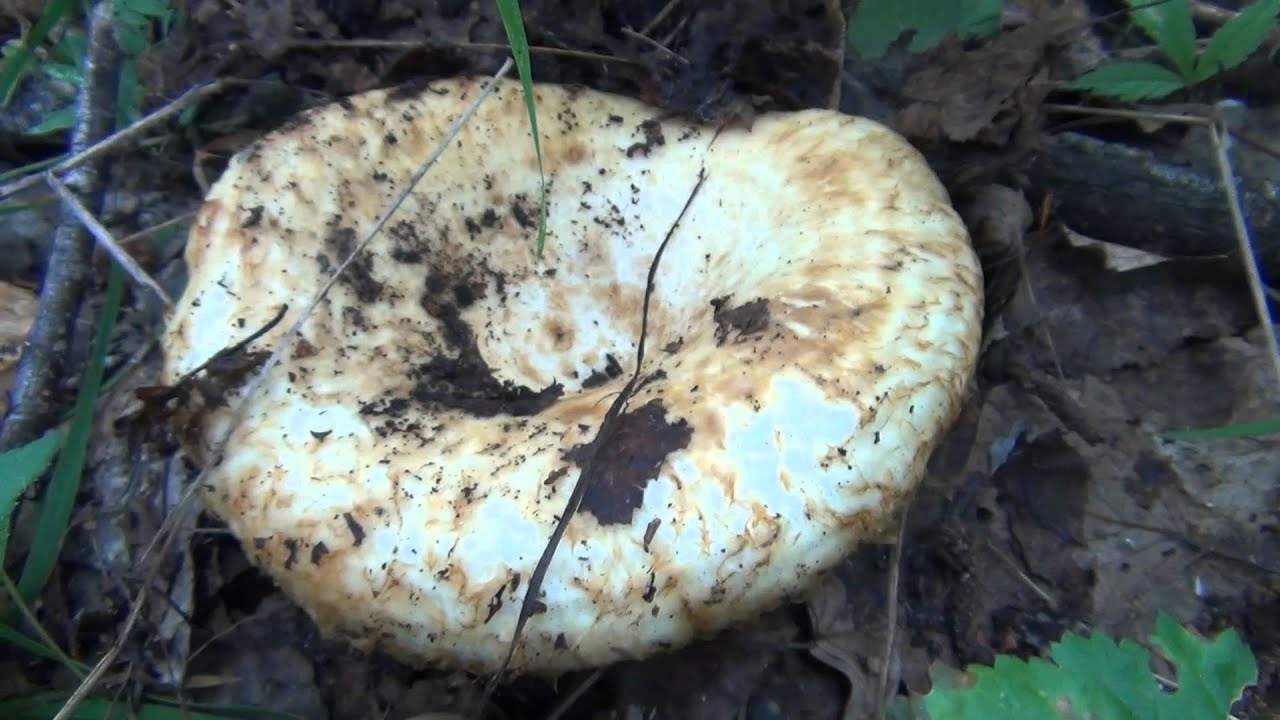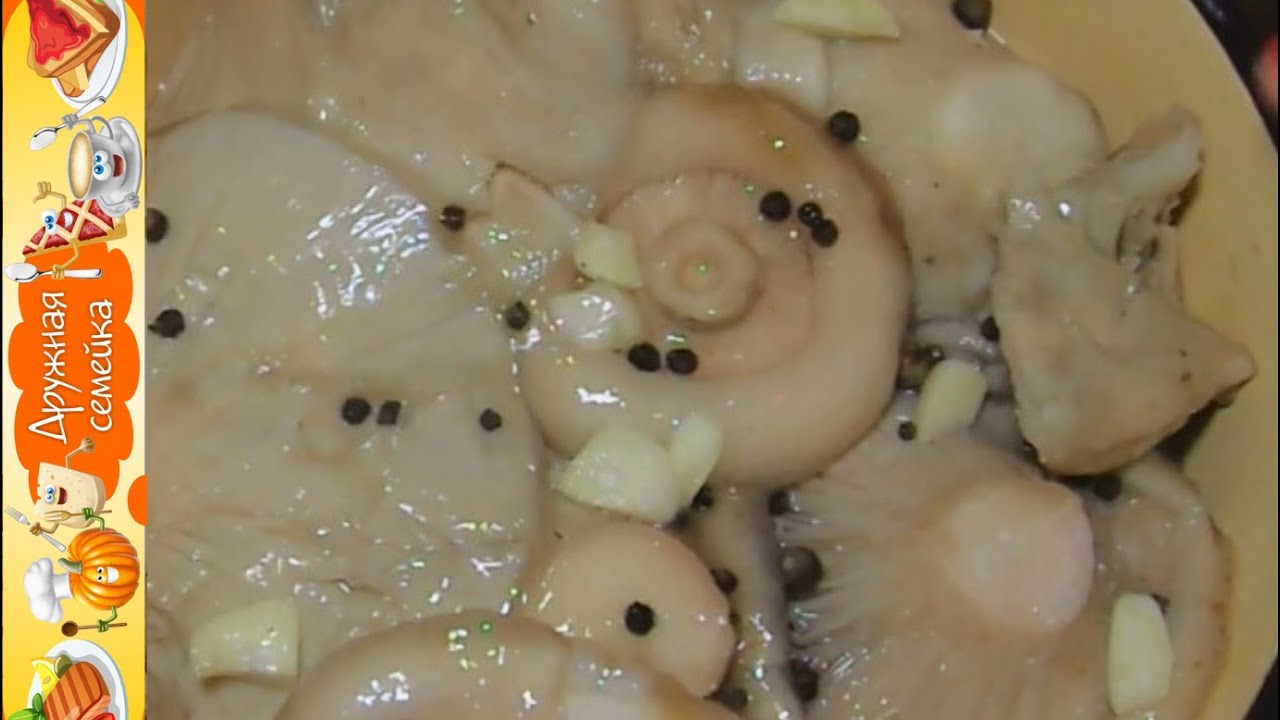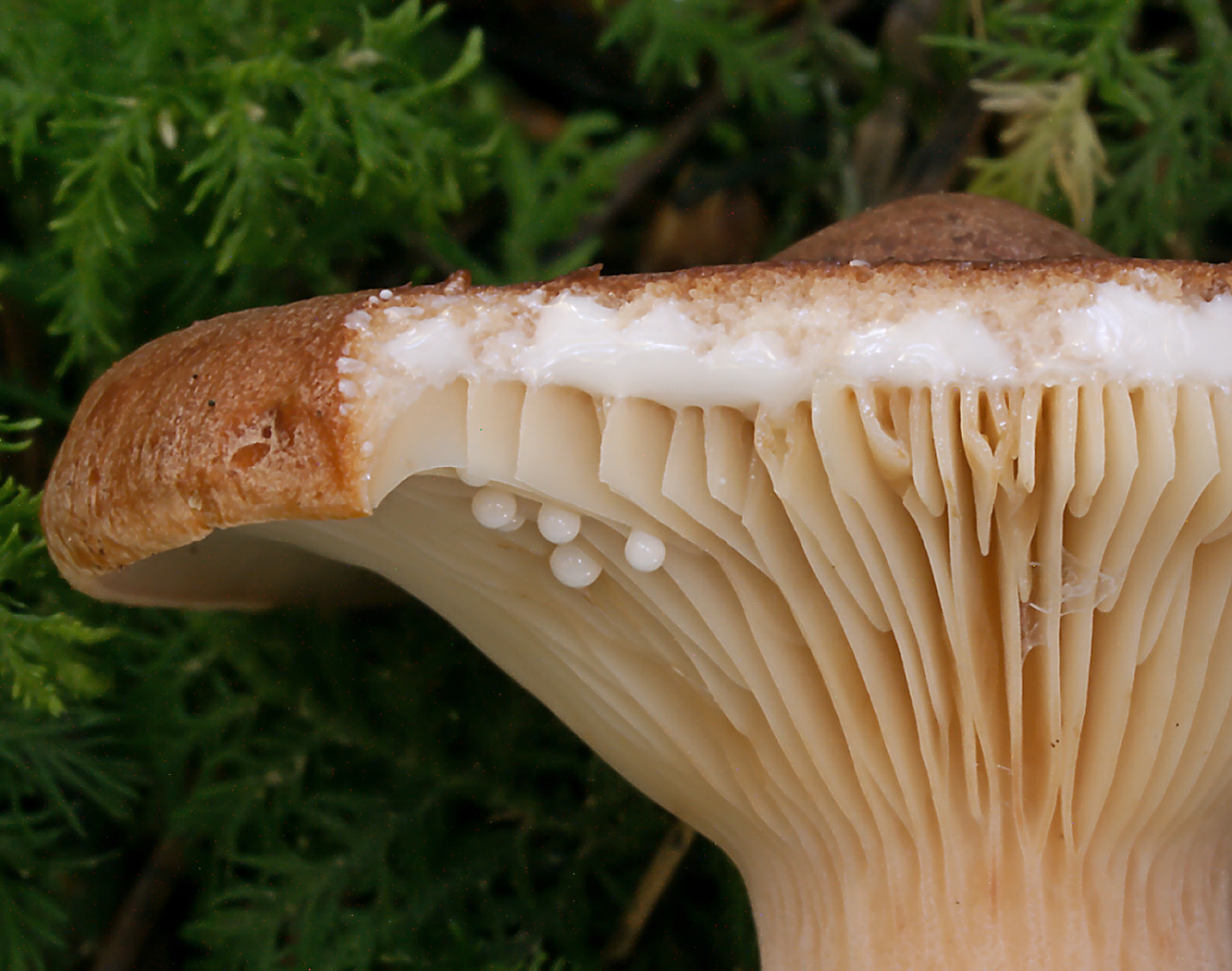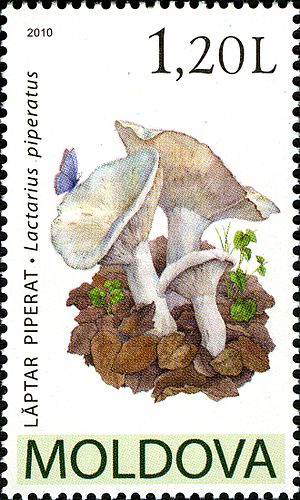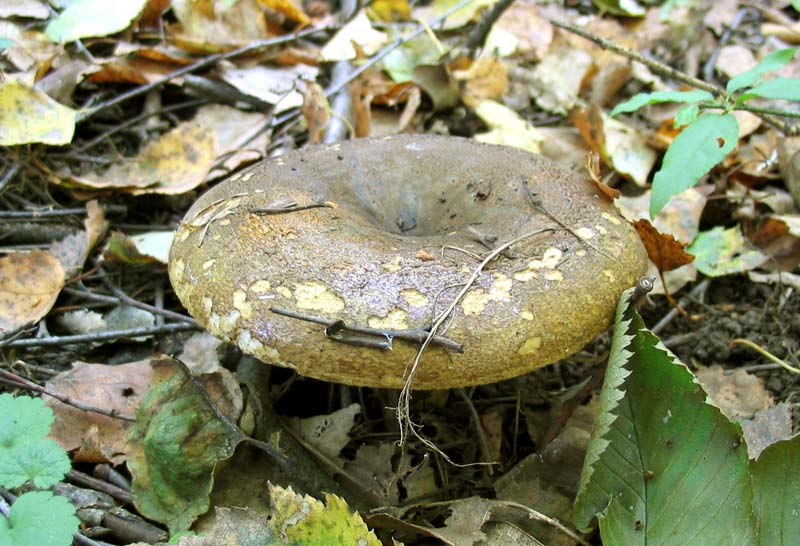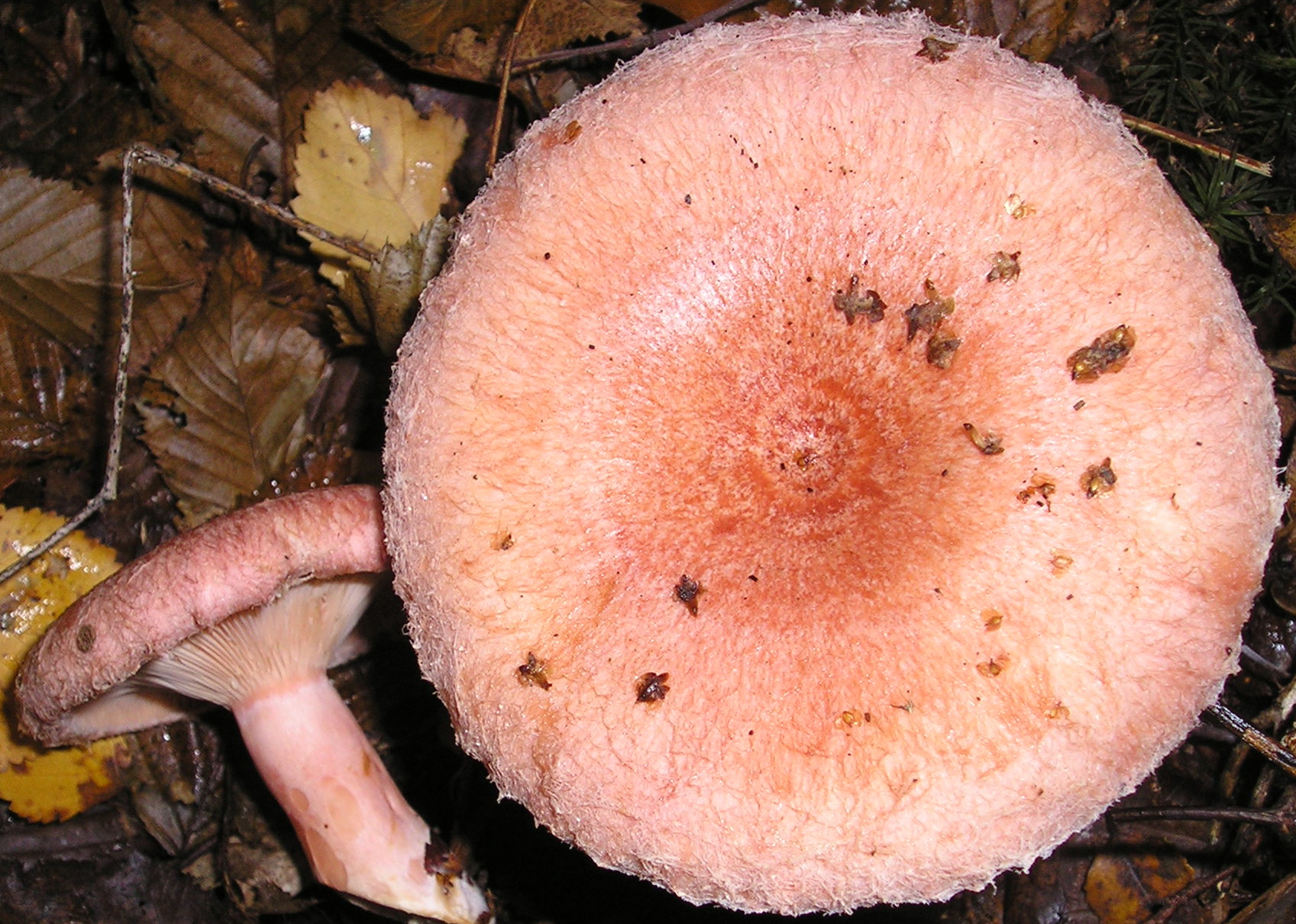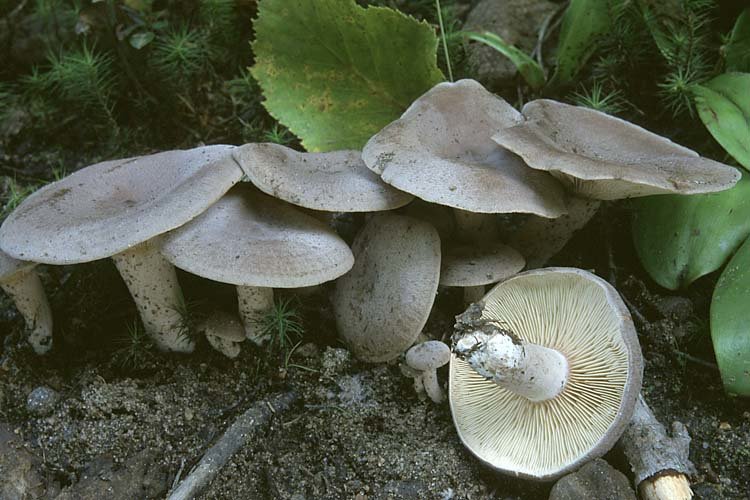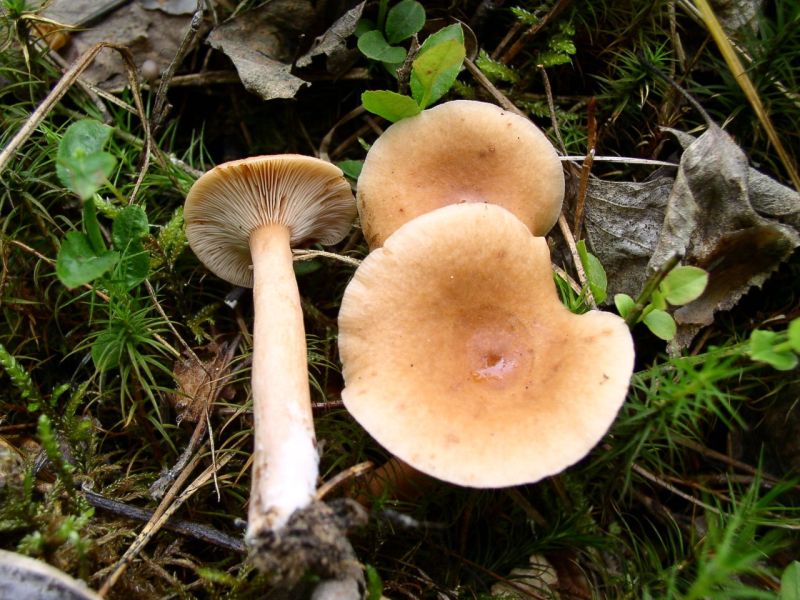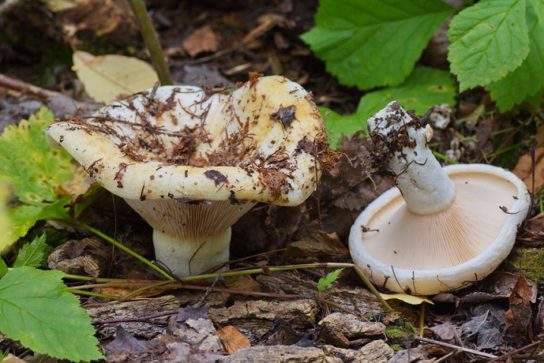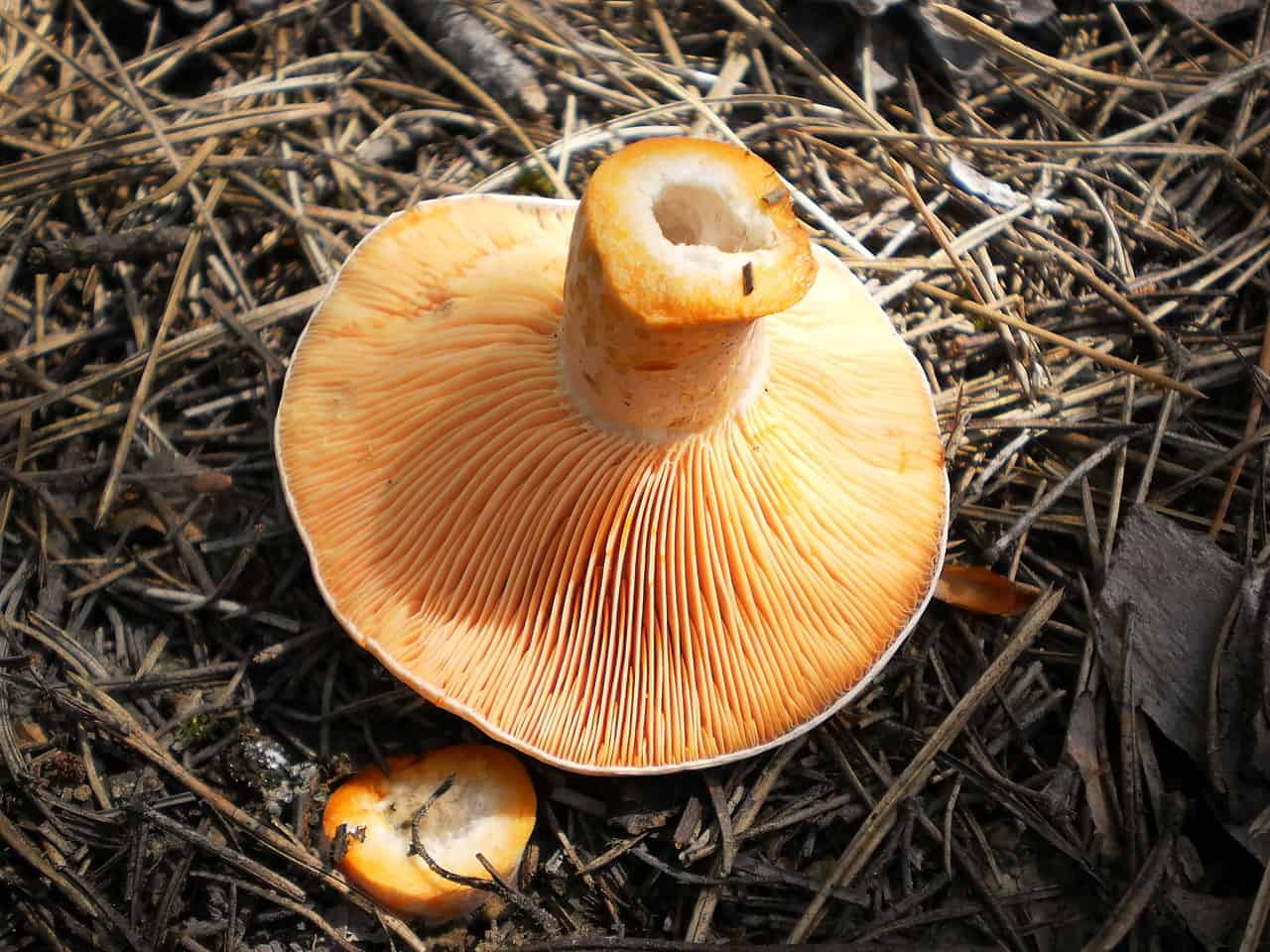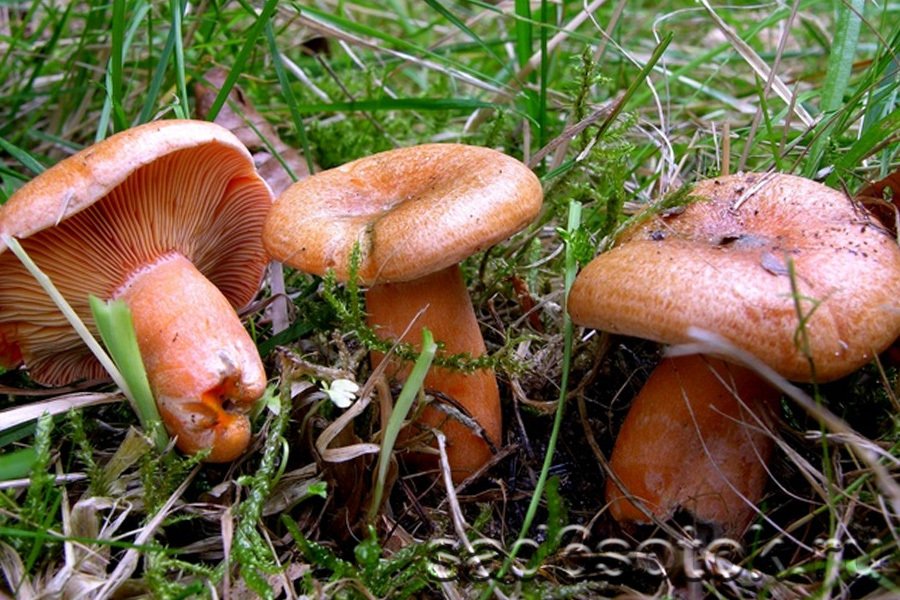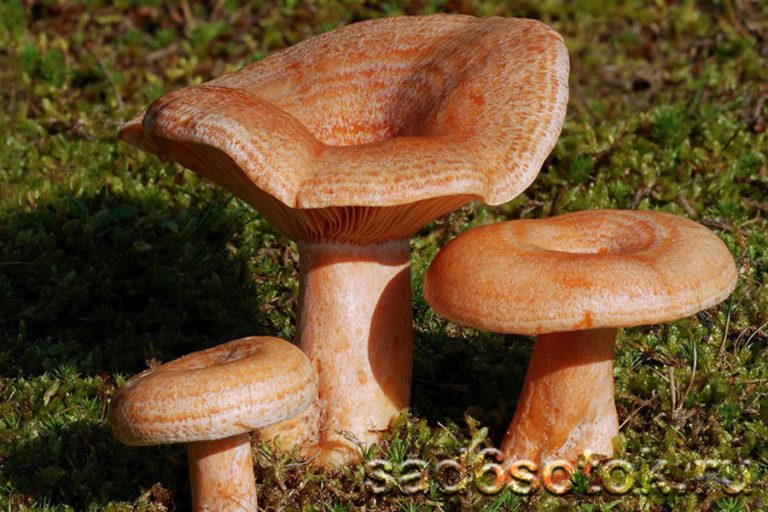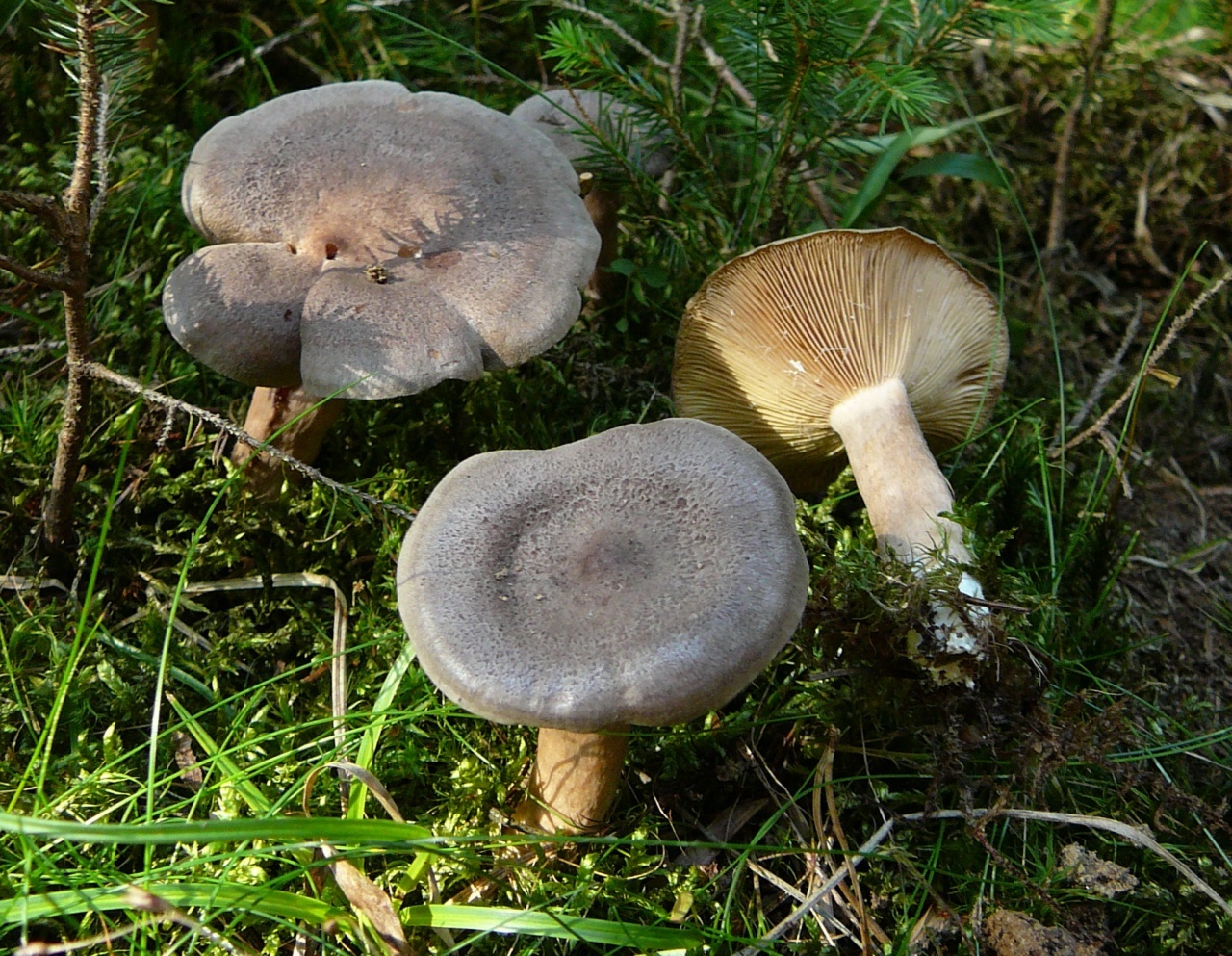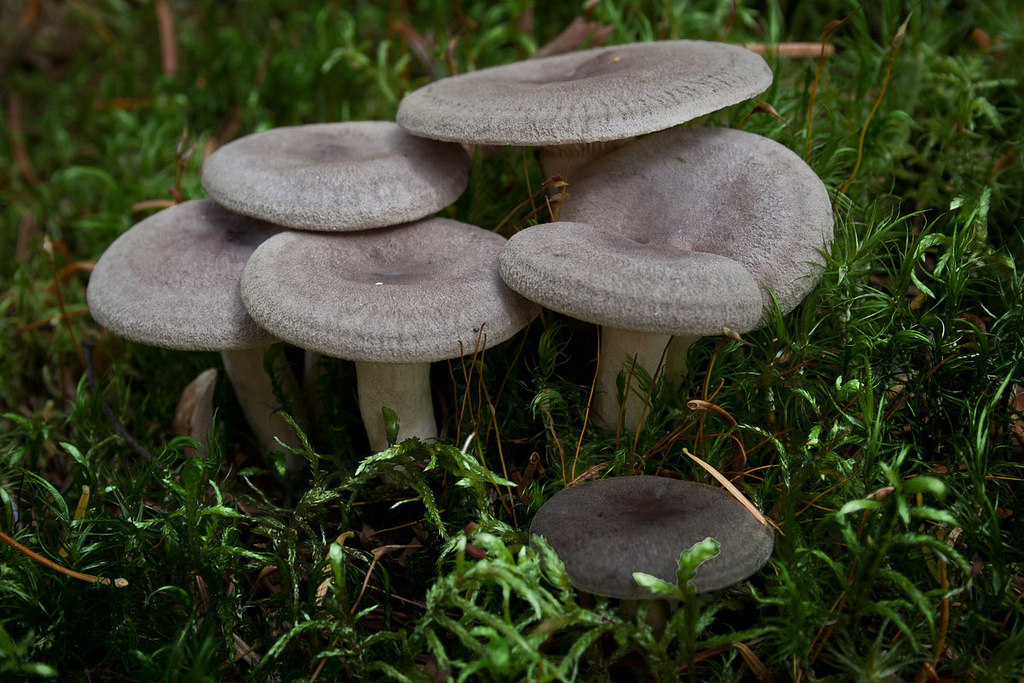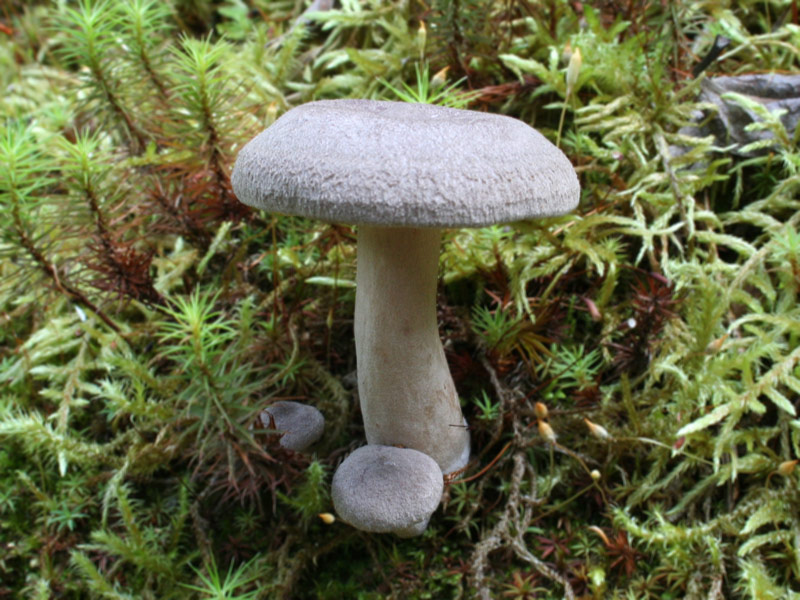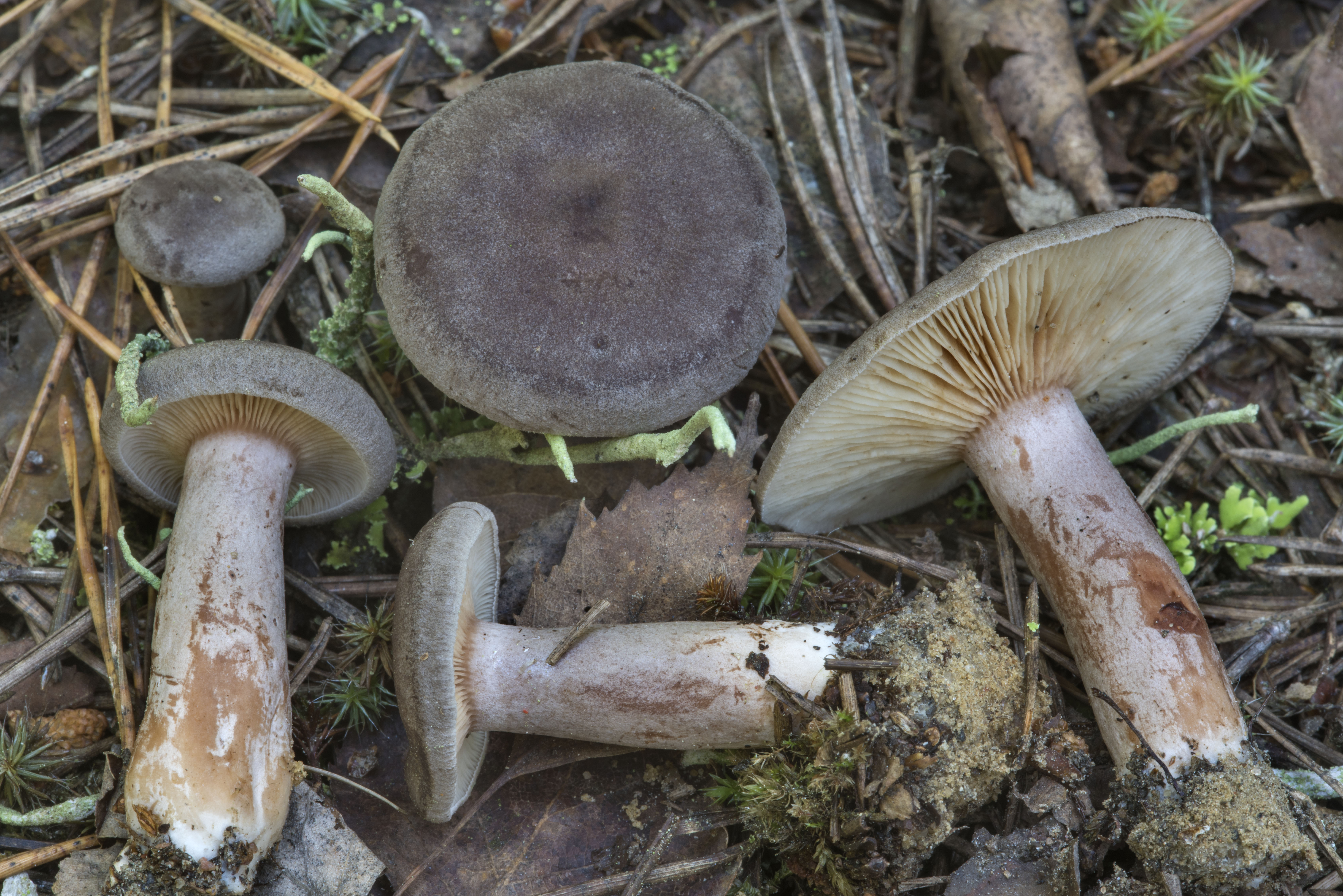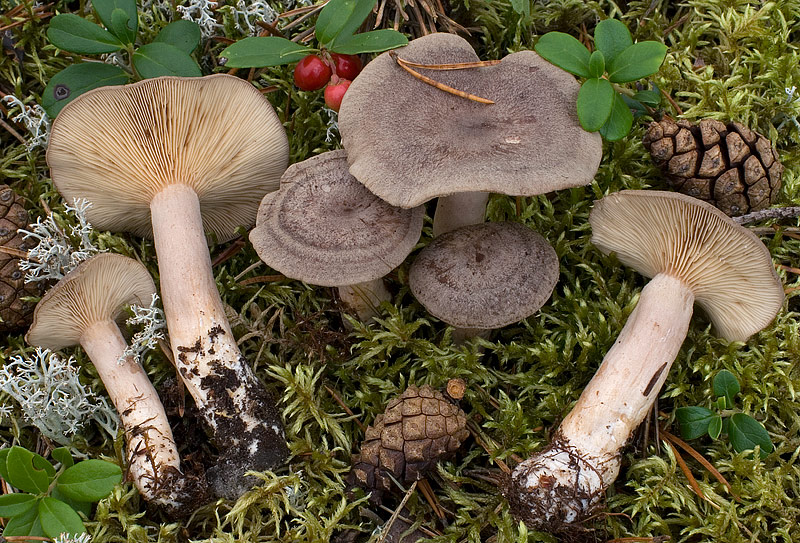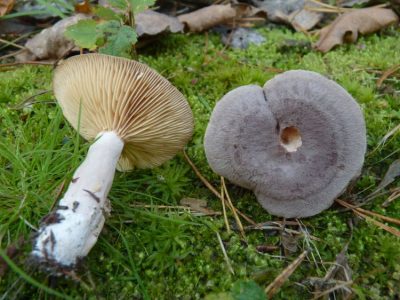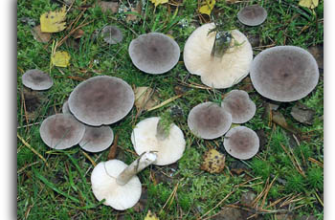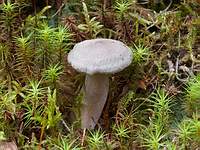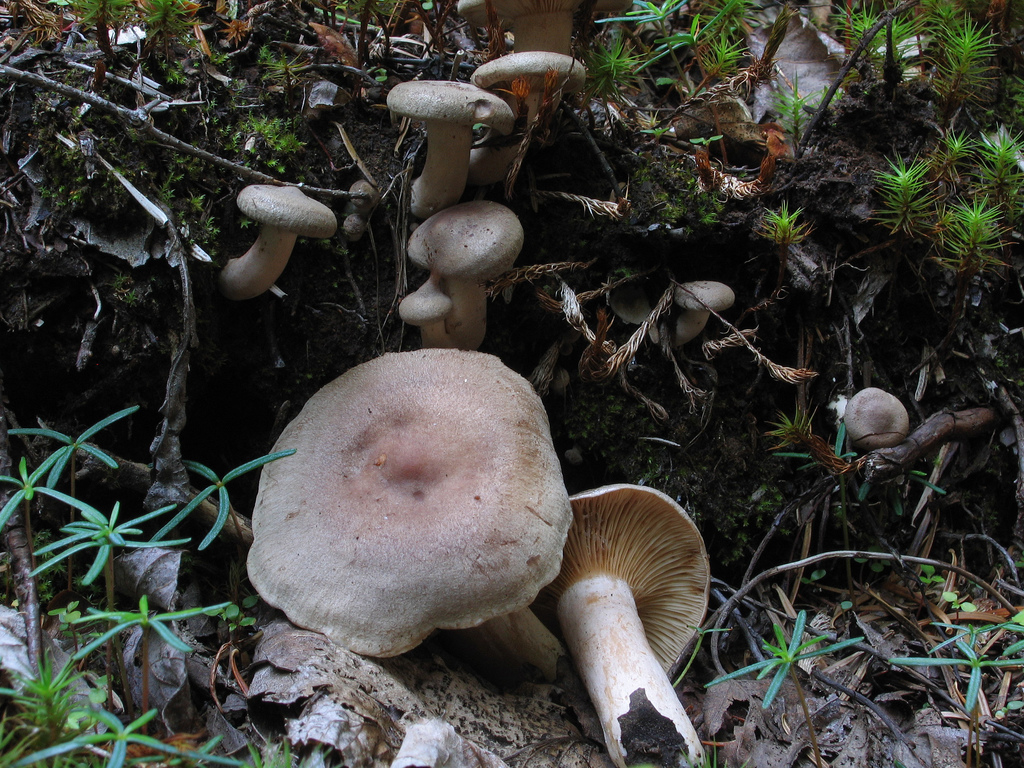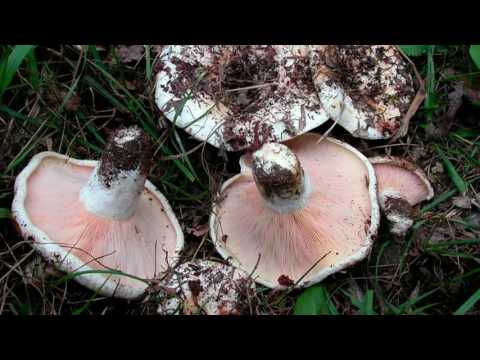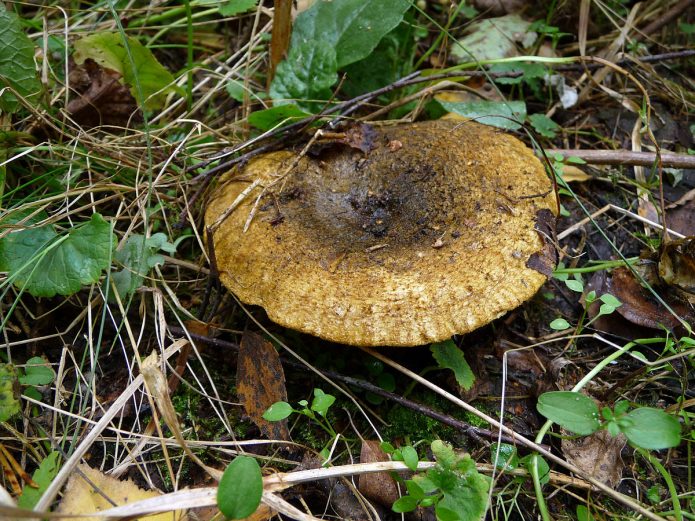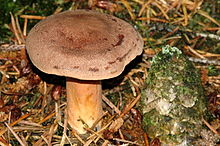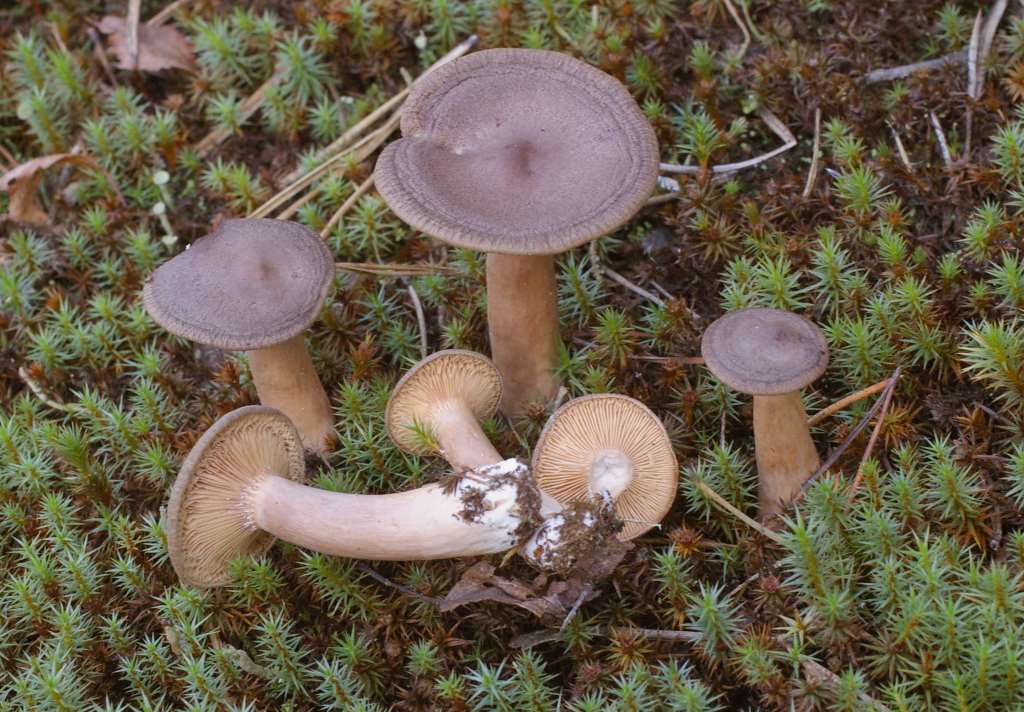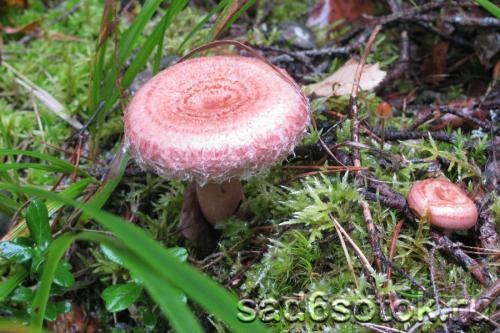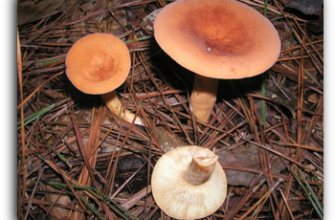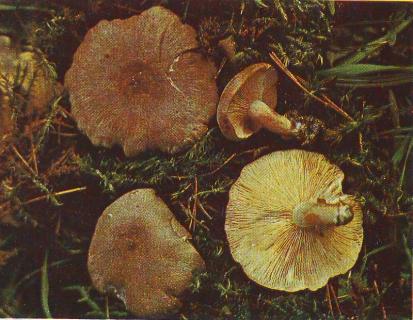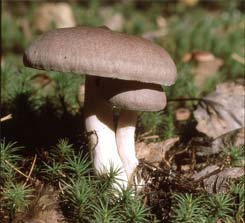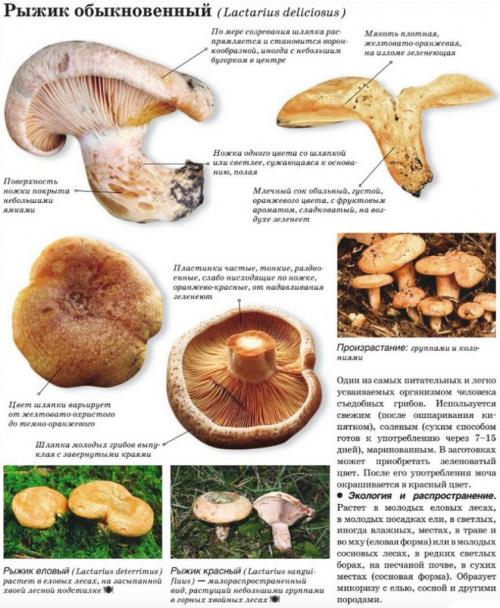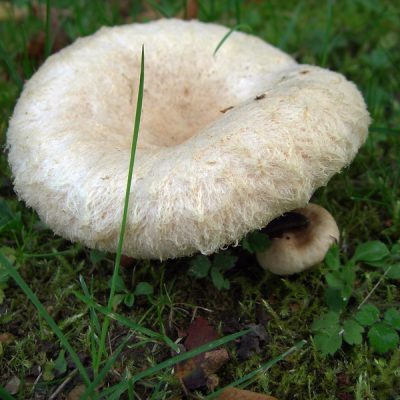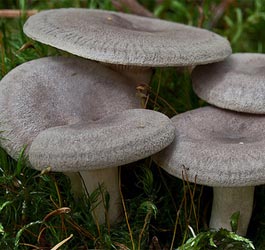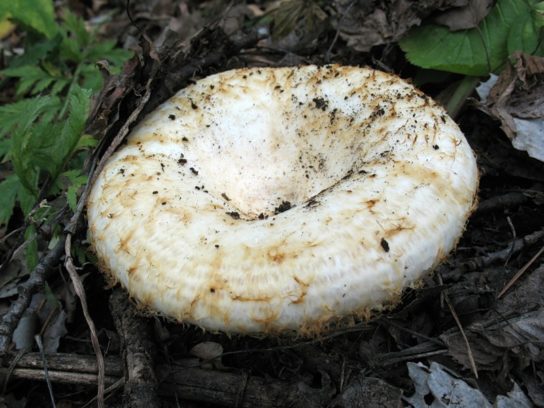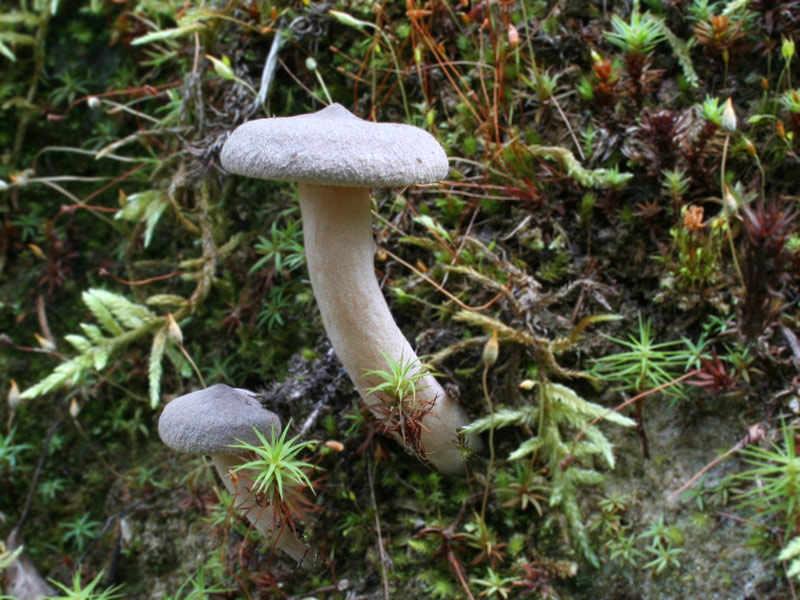Violinist (Lactarius vellereus)
Other names:
- Skripun
- Squeaky
- Spurge
- Milk scraper
- Dry sugar
The violin (lat.Lactarius vellereus) is a mushroom of the genus Mlechnik (lat.Lactarius) of the russula family (lat.Russulaceae).
The head of the violin ∅ 8-26 cm, fleshy, dense, first convex, then funnel-shaped, with the edges, in young mushrooms bent, and then open and wavy. The skin is white, all covered with white hair, as well as the leg - 5-8 cm in height, ∅ 2-5 cm, strong, thick and dense, white. The white cap becomes either yellowish or reddish-brown with ocher spots. The plates are cast greenish or yellowish, sometimes with ocher spots.
The plates are whitish, 0.4-0.7 cm wide, rather rare, not wide, interspersed with short plates, more or less descending along the pedicle. Spores are white, cylindrical.
The stem of the violin is 5-8 cm in height, ∅ 2-5 cm, strong, thick and dense, white. The surface is felt, like the top of the cap.
The pulp is white, very dense, firm, but brittle, with a faint pleasant smell and a very pungent taste. At the break, it emits white milky juice, which practically does not change color when dried. The taste of milky juice is soft or slightly bitter, not pungent.
Variability: The white head of the violin takes on a yellowish, then a reddish-brown hue with ocher spots. The plates are cast greenish or yellowish, sometimes with ocher spots.
The violin has a twin brother - Bertillon's milkman Lactarius bertillonii, visually indistinguishable. The difference is only in the taste of the milky juice: in the violin it is soft, sometimes only slightly tart, while in the milkman Bertillon it is very hot
Of course, it is necessary to carefully separate the milky juice from the pulp for "tasting": the pulp of both types is very spicy. Also for identification, you can use a solution of potassium hydroxide (KOH): under its influence, the milky juice L
bertillonii turns yellow and then orange, while the violin does not have such a reaction.
It differs from pepper mushroom (Lactarius piperatus) in more rare plates.
Edible when salted after soaking.
Mushroom photo Violinist from questions in recognition:
Violin: features of the mushroom, its description and photo. Similarities and differences between the violin mushroom and the real mushroom and other similar mushrooms. How is the violin used?
Hello dear reader!
Of course, one of the most coveted "mushroom trophies" for a mushroom picker in our forests will be a real milk mushroom (otherwise called a white milk mushroom, or still wet).
But wishes do not always come true. It seems that they saw something similar ... Something so white peeps out of the forest floor. Let's take a closer look.
The violinist often "hides" in the grass and forest floor
Alas ... Not that! Understandable disappointment is not a real lump at all! What then?
Before us is another representative of the same genus Lactarius (Millechnik). But it is a much less valuable violin mushroom (Lactarius vellereus).
Taste qualities of a bluish mushroom
These conditionally edible mushrooms belong to the 2nd category of edibility. Glaucous milk mushrooms have a pleasant smell. They are used for salting. For proper salting, glaucous milk mushrooms must be pre-treated with a saline solution, to which a large amount of spices are added. The color of the bluish mushroom after cooking is unappetizing - bluish, so it does not enjoy special love among mushroom pickers.
Similar species
The papillary mushroom is also a conditionally edible mushroom. His cap is flat with a small tubercle in the center. The diameter of the cap is from 3 to 9 centimeters, its surface is scaly, dry. The color can be from gray-brown to dark brown, sometimes a lilac shade is observed. If you press on the cap, it will become brown-ocher.Thanks to this shade, the papillary milk mushroom differs from other species.

The plates are weakly descending, often located. Ornamented spores, grayish in color.
The color of the leg matches the color of the cap, but it can be slightly lighter. The leg length is 3-7 centimeters. The pulp is dense, very brittle, white, practically odorless, but as it dries, it acquires a coconut aroma.
The papillary milk mushroom tastes bittersweet. These mushrooms grow on sandy soil in groups. They can be found in wet areas of the forest, under leaves. Favorite growing places are ravines and sheltered places from the sun.
Aspen mushroom has a fruity smell. The diameter of the cap of the aspen weight is 6-30 centimeters. The structure of the cap is very dense and fleshy.

The shape is plano-convex, the center is slightly depressed. The edge of young mushrooms is slightly fluffy and bent downward; as it grows, the edge is leveled and wavy. The skin is white. The surface is covered with pink spots and a little fluff. In wet weather, the cap becomes sticky.
The pulp is brittle, dense, whitish in color. The plates are frequent, not wide, descending along the stem, light pink in color, becoming light orange as they grow.
Spore powder is pinkish. The leg length varies from 3 to 8 centimeters. In structure, it is dense, strong, whitish or pink in color. There is a milky juice, it is abundantly secreted and has a pungent odor.
The smell of aspen mushrooms is weak and pleasant, and the taste is pungent. The harvest season is July-September. These fungi form mycorrhiza with poplars, aspen and willow. They grow in damp aspen forests, rarely found in poplar forests. Aspen milk mushrooms bear fruit in small groups. These are quite rare mushrooms; on the territory of our country they are found in the Lower Volga region. Aspen milk mushrooms are conditionally edible mushrooms that need preliminary soaking.

Aspen milk mushrooms, fluffy, tender and papillary
Aspen milk mushroom (Lactarius controversy) is conditionally edible. The cap is 10-30 cm, concave, with a deep tucked edge, white. The plates are thick, light pink. The leg is white, short, 3-7 cm long, 2-4 cm thick. Milk is white, does not change color, with a burning taste. The spore powder is colorless or white.
Grows in aspen groves that have arisen in self-sown aspen fields. Grows in groups hidden in the grass, together with aspen. It is also found under poplars.
Fruiting from August to October.
The aspen mushroom has no poisonous counterparts.
The mushroom is fluffy, white (Lactarius pubescens) has a cap with a diameter of 2–7 cm, thin-fleshy, concave-spread, with a swirling shaggy edge, hairy. With age, the cap is usually naked, sticky, cream-colored, darker in the center - to ocher or pinkish-ocher. The plates are narrow, whitish, pinkish-cream over time. Leg 2-5 x 1-2 cm, whitish at the top, reddish or pinkish-reddish downward, hollow. The pulp is dense, white, pungently pungent. Milky sap is white, pungently pungent, does not change color in air.
Growth. Grows under birches.
Fruiting. Forms fruiting bodies in August - October.
Usage. Inedible mushroom.
The tender milk mushroom (Lactarius tabidus) is described as similar to the marsh mushroom. The cap is 1–3.5 cm in diameter, often with a cone-shaped tubercle in the center, orange-reddish-brown or orange-reddish-red, with a ribbed edge. Leg 2-4 x 0.1-0.3 cm, cap color. Milky juice is white, turns yellow in air.
Growth. Occurs in swampy areas among mosses.
Fruiting. Forms fruiting bodies in August - October.
Usage. Nutritional qualities have not been studied.
The papillary lactus (Lactarius mammosus) has a cap with a diameter of 3-9 cm, thin fleshy, flat or concave-spread, often with a tubercle in the center, first with a bent and then a spread edge.The hat is gray-brown, dark brown, dark gray-brown or black-brown, sometimes with a violet tinge, fading to yellowish with age, dry, fibrous-tomentose or fibrous-scaly. The plates are frequent, narrow, yellow, with time reddish-reddish, with pressure they turn brown. The leg is 3-7 × 0.8-2 cm, cylindrical, with a canal over time, whitish, with age, the color of the cap, in places of pressure becomes brown-ocher.
The flesh of the cap is whitish, dark under the skin, and reddish-reddish in the stem, dense, sweetish, odorless in fresh mushrooms, fragrant when dried. Milky sap is white, the color does not change in air, at first it is sweetish, then pungent or bitter, in old mushrooms it is almost absent.
Growth. Grows in coniferous forests on sandy soils, usually in groups.
Fruiting. Forms fruiting bodies in August - October.
Usage. Inedible mushroom.
This video shows milk mushrooms in their natural habitat:
Description of the bluish weight
The diameter of the cap ranges from 4 to 12 centimeters, and in especially large specimens it can reach 30 centimeters. The cap is white, convex in shape and with a concave central part; in mature specimens, the cap straightens, its shape becomes funnel-shaped.

The surface is dry, slightly velvety, with cracks. The color contains ocher and cream spots.
The plates are of the same color with the cap, sometimes they can be cream, narrow, often located, forked, descending along the stem. At first, the plates are yellowish, later they become pink-cream.
The leg is smooth, very dense, cylindrical in shape. The leg length ranges from 3 to 9 centimeters, and the diameter is 1-2 centimeters. Often there are ocher or fawn spots on the stem. Sometimes the legs are hollow, from white to bluish in color.
The pulp is very firm, but brittle, white in color. When broken, the color of the pulp changes gradually, about an hour or more. The pulp has the smell of fresh sawdust or rye bread, and the smell of bluish mushrooms is comparable to a weak honey aroma.

Milky sap is extremely pungent, white in color; in air it gradually turns green and curdles. The pungency of this juice can be felt instantly. Spores are round or elliptical, ornamented, white in color.
Places of growth of bluish
These mushrooms grow in deciduous forests, but sometimes come across in coniferous forests. Glaucous mushrooms settle in small groups, and the distance between different groups does not exceed 30 meters.
Glaucous milk mushrooms love calcareous soils. They can easily endure dry seasons. Glaucous mushrooms can grow in the very thicket of the forest and in open meadows.

External description of the mushroom
The fruiting body of a wet lactarius consists of a stem and a cap. The height of the leg is 4-7 cm, and the thickness is 1-2 cm. Its shape is cylindrical, slightly widening at the base. The structure at the foot is strong and durable, and the surface is sticky.
It is very rare to meet this type of mushroom, a distinctive feature can be called the color of the cap, which varies from grayish to gray-violet. Its diameter is 4-8 cm, in young mushrooms it has a convex shape, which becomes prostrate over time. On the surface of the cap of old, mature mushrooms, there is a depression, as well as a wide flattened tubercle. The edges of the cap are bordered with small villi and bent. Above, the cap is covered with a grayish-steel skin, with a slight shade of purple. It is wet, sticky and smooth to the touch. These characteristics are especially common in humid climates. A vaguely expressed zoning sometimes appears on the surface of the cap.
The fungus hymenophore is represented by plates containing white spore powder. The plates themselves are small in width, are often located, descend slightly along the stem, initially have a white color, but turn yellow over time. When pressed and damaged, purple spots appear on the plates.The milky juice of the fungus is characterized by a white color, but under the influence of air it acquires a purple hue, its release is very abundant.
The structure of the mushroom pulp is spongy and tender. It does not have a characteristic and pungent smell, but the taste of the pulp is distinguished by its sharpness. In color, the pulp of the wet lactarius is white or slightly yellowish; in case of damage to the structure of the fruiting body, a shade of purple is mixed with the main color.
Violin mushroom - characteristic features
The violin, like the real milk mushroom, is closely connected with the birch in its life. The fungus forms mycorrhiza with this tree, and grows in forests where there is always a birch.
Usually, these two fungi are found in almost the same areas of the forest. And very often the mushroom picker is mistaken. I was hoping for a valuable booty ... but got a creak!
Squeaks, squeaks - these are even more common names than the "official" name of the mushroom - violin. Received their mushroom for a very characteristic creak, which is heard, for example, when cutting the fruit body.
What are the most obvious signs of a violin mushroom?
The violin is a dense mushroom, often very large. The diameter of the cap of a mature fruiting body can reach 15 - 20 cm.
In a young mushroom, the cap is almost flat, white. Later, it becomes funnel-shaped, acquires a yellowish tint. On the cap of a mature mushroom, yellow spots are often visible.

The mature fruiting body of the funnel-shaped violin fungus
But there are no concentric circles, albeit implicitly expressed, like a real breast, on the head of the violin. The edge of the cap is usually tucked up. But the "furry" of the edge, along which a real white lump is easily identified, is not observed in the violin either.
And the surface of the cap of the violin mushroom is predominantly dry. Unless, of course, you are considering a mushroom in the rain.
But on the hat there is usually a lot of adhered forest debris, which is not so easy to clean.
The stem of the violin mushroom is short and thick, dense.
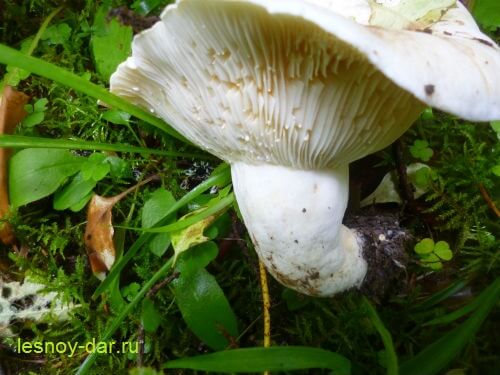
The violin's leg is thick and rather short
The plates are descending, rather rare and thick. The color of the plates can be white or pale yellow.
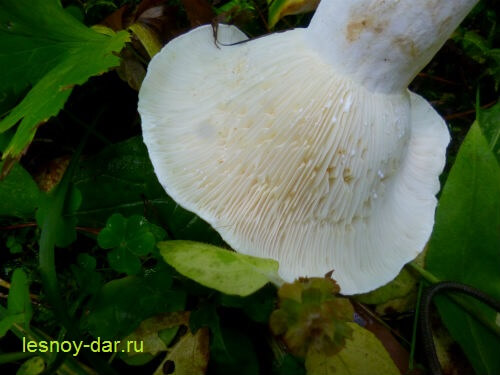
Such are the plates of the violin mushroom
A plentiful white milky juice is released on the cut, which slowly turns yellow in air. Drops of milky juice can also be seen on damaged plates. This juice tastes very bitter.
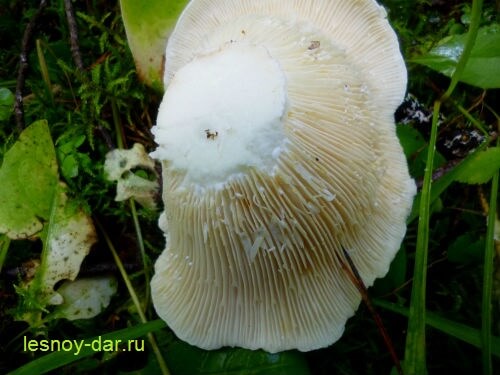
The violin has abundant bitter white milky juice, which gradually turns yellow in the air.
The violin fungus is extremely rarely damaged by insect larvae. Mushroom mosquitoes do not like it! However, this does not mean at all that the mushroom is poisonous.
Comparison of the violin mushroom with similar mushrooms
The easiest way is to distinguish between a violin and a real lump. These mushrooms are similar only from a distance, in white. Moreover, the milky juice from the violin and the weight is bitter, white, yellowing.
The cap of a real lump is usually wet, slightly shaggy. There are noticeably more hairs along the edge. Concentric rings are visible on the surface.
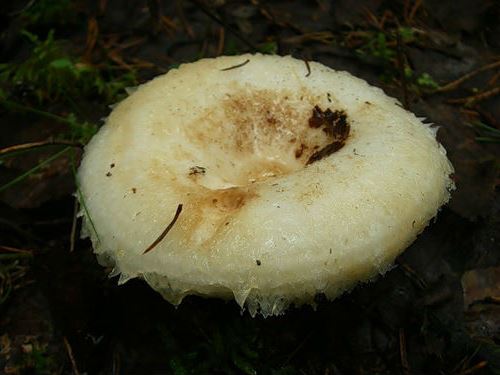
It looks like a real load
The violin's hat is dry. There are no hairs. Concentric zones are not pronounced.
Another bitter milkman is similar to the violin - the peppermint. I rarely meet him here. It is predominantly an inhabitant of deciduous forests. But pepper mushrooms form mycorrhiza not only with oak, but also with birch.
The peppermint also has a very bitter milky juice. But in the air it does not turn yellow, but turns blue. And the plates of the pepper mushroom are more frequent than those of the violin.
And yet, in my opinion, the bitterness of pepper milk is not removed by any soaking or boiling. I remember I soaked it for five days, but after salting the mushroom remained bitter!
Outwardly, many are similar to a mushroom with a white fiddle, otherwise called "crackers". The same large white funnel-shaped fruiting bodies. And there is always a lot of garbage on the hat.
Here are just no milky juice (and therefore "cracker"). And there is absolutely no bitterness. And in general - the podgruzdok belongs to another genus - Russula (i.e., Russula).And you can fry the load immediately, only by bringing it from the forest. But most often "crackers" come across extremely wormy.
Cooking recipes
The violin belongs to conditionally edible mushrooms, which have been assigned the fourth category of edibility. When properly processed, it is safe for the body, therefore it is successfully used in cooking. Skripun can be cooked for future use, pickled, salt.
Primary processing and soaking
Before proceeding directly to the cooking process, it is necessary to carry out the primary processing of the fruit bodies in order to remove the milky juice from them.
Algorithm of actions:
- Go through the mushrooms.
- Remove adhering leaves, moss and dirt particles.
- Rinse thoroughly with running water.
Then you can move on to the soaking process, which will help get rid of the taste of bitterness, toxins and harmful elements. Soaking should be done in two ways:
- Immersion in cold water. It is necessary to place the mushrooms in salted liquid, in which they should remain for 5-7 days, periodically change it to fresh.
- Pouring boiling water over. This method is considered faster, after 3 days the mushrooms are ready for further processing. In this case, the water will have to be changed quite often - up to 5 times a day.
Is it possible to fry and boil the violin mushroom?
The violin is suitable for eating only in salty form. When boiling or frying, the bitterness in the fruit body is preserved, and when eating the violin prepared in this way, there is a risk of adverse effects.
Salting
Salty violin is much inferior in taste to white milk mushrooms. But if you find the right recipe, you can get a great snack with a pleasant aroma. For preparations for the winter, fruits with a large and fleshy cap are suitable. In this case, it is recommended to select whole and fresh fruit bodies without signs of worminess.
Hot
Ingredients:
- pre-soaked violin - 1 kg;
- table salt - 30 g;
- fresh currant leaves - several pieces;
- filtered water;
- allspice - a few peas;
- cloves - 2-3 pcs.;
- bay leaf - 1 pc.
Recipe:
- Pour water into an enamel pot, add salt.
- Place the mushrooms in it, blanch them for 20-30 minutes, constantly removing the foam.
- Throw in a colander.
- Wait for cooling.
- Put currant leaves on the bottom of the jar, add spices, add bay leaf.
- Lay the squeaks on top with the caps down, while sprinkling each layer with table salt.
- Cover with currant leaves on top, close the lid and refrigerate for 1.5 months.
Cold
Salt for the winter can be cold.
The following ingredients are required:
- felt mushroom - 1 kg;
- table salt - 50 g;
- bay leaf, cloves, peppercorns, garlic cloves - to taste;
- currant or cherry leaves - several pieces.
How to salt a violin:
- Put the mushrooms in a wooden container in dense layers, caps down, sprinkle each with salt and spices.
- Cover with a ceramic plate on top and place the load.
- Wait until liquid is released. It should cover the mushrooms completely, and if this does not happen, then top up with a saline solution prepared at the rate of 20 g of salt per 1 liter of water.
- Put the prepared squeak in sterilized jars, caps down.
- Cover the salting with currant leaves on top.
- Close with lids.
- Put in the refrigerator for 1.5 months.
Hot crispy pickled squeaks
Felt milk mushrooms can also be pickled and rolled up in jars. This process is more time consuming as the mushrooms need careful preparation. But, according to reviews, the pickled squeak is crispy and aromatic.
Ingredients:
- violin - 1 kg;
- water - 1 tbsp.;
- table salt - 40 g;
- onion - 1 pc .;
- cherry leaves - several pieces;
- horseradish leaf - 1 pc .;
- dill umbrella - 1 pc.;
- black peppercorns to taste.
Step-by-step pickle recipe:
- Peel and rinse the mushrooms in cold water at least three times.
- Cover with water overnight.
- In the morning, drain the water and rinse each mushroom under the stream again.
- Put in an enamel container, cover with water and bring to a boil, periodically removing the foam that appears.
- Throw in a colander or sieve.
- Rinse again and soak in cold water for half an hour.
- Drain the liquid, rinse the mushrooms several times.
- Prepare sterilized jars.
- Place spices on the bottom, a layer of mushrooms on top, on them rings of chopped onions and a horseradish leaf.
- Boil marinade water with salt and pepper.
- Pour the brine over the mushrooms, sterilize the jars for 30 minutes, roll up.
Papillary milky, Lactarius mammosus
Hat: Small (3-8 cm in diameter), in young mushrooms, strictly rounded, compact, with tucked edges, further opens, acquiring an irregular “flat-depressed” shape, often with a clearly distinguishable central tubercle. The color is gray-gray, lighter with age, with noticeable concentric zones. The surface is dry, slightly velvety. The flesh of the cap is white, brittle; milky juice is white, not plentiful, sweetish or slightly pungent. The smell is peculiar, not always clearly distinguishable, according to descriptions it resembles a coconut.
Hymenophore: The plates are frequent, narrow, adherent with a tooth, in young mushrooms are white, as the spores mature, they darken somewhat.
Spore powder: Grayish.
Leg: It is 4-7 cm long, 1-2 cm thick, cylindrical, even, often curved, painted in the tone of the cap, but lighter. The flesh of the leg is fragile; as the mushroom matures, it becomes full or hollow.
Spreading: Miller papillary bears fruit in small groups from mid-August to late September in coniferous and mixed forests (apparently with pine), preferring sandy soils. In some sources, it is designated as a "rare species".
Similar species: The nondescript Lactarius mammosus is easy to confuse with a whole host of second-class milkmen. Among them, Lactarius pyrogalus stands out in an amicable way, the stinging milky milky, which grows in completely different places, is extremely pungent and is colored “brownish”. The faded lactarius, Lactarius vietus, grows differently; as a rule, he does not have concentric zones on the cap either. It also smells like coconut and the aromatic lactarius, Lactarius glyciosmus, is otherwise not alike. Finally, the glamor, famous in the fungal environment, Lactarius trivialis, is much more powerful and is similar to the papillary lactate only in color.
Edibility: Suitable as a filler in brine for other, more serious milkers; the lean constitution and fragile flesh do not allow the papillary milkman to fight with dignity for a place in the basket.
Author's notes: There are technical mushrooms, there are food, there are poisonous, there are funny. and there are like this here is our milkman. Children in modern computer games (from which, however, both children and games become irrepressibly dull; remember what games were in our times?), The system of “achievements” (from the English achievement) is popular, that is, achievements that make it possible to measure the gameplay with friends. Found a rare artifact, built a beautiful castle, raised a fat pig - an achievement, please. Here is the papillary lactate - a ready achievement. Came, saw, identified - great, another milkman. Exactly one more milkman than was on the list before. Mushroom achievement.
The hats are already shapeless, there is no named tubercle, the legs are hollow, the milky juice almost does not flow. One word is maturity. But in this form, the mushroom already clearly smells of "coconut". (Only for me this is not a coconut, not a coconut.)

If young specimens of the papillary lactate are dried in the sun, without allowing them to mature, then they will gain eternal youth - they will remain round, folding, sharp-tuberous. But the juice will not be due in them all the same.

This milkman tolerates dry, but not hot weather - unlike most of his "foster brothers". Where more massive congeners suffer damage, the papillary lactic acid blossoms and reproduces.

This is what a well-developed Lactarius mammosus should look like.The size of the fruit bodies should not confuse a person: in the photo there are quite mature specimens.
Botanical description
Ryzhiks got their name from their bright orange, and sometimes even reddish hue, due to the high content of beta-carotene, which in the body turns into retinol or just vitamin A.
The cap of these representatives of the mushroom kingdom ranges in size from 4 to 14 cm.The color is bright from ocher-yellow to dark orange, shiny. The shape is spherical, convex. A depression may form in the middle, and the edges of young mushrooms are tucked up. With age, the edge of the cap straightens, and it acquires a funnel-shaped shape. The surface is smooth, sticky, slightly slippery. There are girdle rings on it, sometimes a whitish bloom. At the bottom of the cap there are many thin orange-red plates that acquire a green tint when pressed.
The leg is small and thin, its height is from 3 to 7 cm, its thickness is up to 2 cm. It coincides in color with the cap, differs only in a lighter shade. Inside, they are hollow, narrowed at the base, small darker grooves are characteristic of the upper part.
The flesh of saffron milk caps is dense, bright orange in color, turns green when broken.
A thick milky juice is released. It also has an orange color, which turns green when exposed to oxygen.
Characterized by a fruity sweetish odor.
Common types of saffron milk caps
Among the types of saffron milk caps, there are three most common: spruce, red, real. They are distinguished by some differences in appearance and places of growth.
Real. It is known as pine mushroom, common mushroom, autumn mushroom, noble mushroom.
The hat is shiny, rather large, up to 14 cm in diameter. The shape is convex, round. Its surface is of various shades - from orange to red. On the surface there are girdles, sometimes a whitish coating. The edges curl inward, mostly in adult mushrooms.
The leg is thick, high - up to 10 cm in length. Its surface is rough, it can be covered with a small fluff.
The plates are bifurcated, thin, extend onto the base of the peduncle and can occupy no more than 1/3 of its entire length.
Collected in moss from June until frost.
Red. Less common than other species. It is distinguished by a flat, wide, shiny, large cap, reaching a diameter of 17 cm. It has a depressed fossa in the center. The hat is fleshy and has an orange-red color. On contact with water, it does not lose its density and does not become slimy. The edges of the cap are bent in young mushrooms, and in adult specimens they do not bend at all. The difference from other species is the absence of circles of spots.
The leg is dense, strong, short, only up to 6 cm in length. There is a mealy bloom and red grooves. The pulp is dense, brittle, white, with randomly located bright red spots. Characterized by a viscous milky juice of a bright red hue at the fracture site. The plates are narrow, frequent, strongly descending along the stem.
Prefers coniferous bedding. It is found mainly in high-mountainous areas from June to September inclusive.
Japanese mushrooms (lat.Lactarius japonicus),
Spruce. Has a relatively small size. Its cap usually does not exceed 8 cm in diameter, the height of the leg ranges from 2 to 6 cm, and its diameter reaches only 1 cm. The spruce mushroom cap is sticky, light orange with a greenish tinge. When ripe, it brightens. The leg is thin. The pulp with a pleasant smell, fragile, at the cut site first acquires a reddish tint, and then turns green. This mushroom is found under spruce trees in a mixed forest from July to September.
False doubles
The uniqueness and recognizable appearance do not allow the mushroom to be confused with other representatives of the mushroom kingdom. But among the varieties of these mushrooms there are some that are not edible mushrooms. They belong to class 4 - conditionally edible mushrooms.These representatives are called false doubles of the saffron milk cap. These include:
The miller is fragrant. A small, brown cap is characteristic, up to 5 cm in diameter. Its edges at any age of the fruiting body are concave inward and slightly torn along the contour. The smell is spicy, very strong, like a coconut. They are used in cooking, salted or dried, as a spice for dishes.
Milk papillary or large lactic acid. It is a conditionally edible mushroom. Grows in coniferous forests. The hat is gray-brown in color, small in diameter. The pulp is brittle, white, pleasant smell. Milky sap is white, does not change color when broken. It is recommended to use it as a food product only after thorough soaking and prolonged salting.
The medicinal properties of the papillary mass.
Due to the content of vitamins, proteins and fats in milk mushrooms, they are often used in medicine.
It would seem, what unusual properties can milk mushrooms have? But these mushrooms have attracted the attention of not only traditional healers, but also professional doctors. Milk mushrooms contain a substance that has a detrimental effect on a variety of bacteria.
They are even used in the fight against tuberculosis.
Since ancient times, papillary milk mushrooms and other types of milk mushrooms have been used to treat the liver and kidneys. They reduce the risk of deposits of stones and salts. They also have a diuretic effect.
Due to the high content of protein in papillary milk mushrooms, they contribute to the healing of wounds, even purulent ones. Salted milk mushrooms are of the greatest value, since during fermentation a special protein is released, and the fruit bodies acquire anti-inflammatory qualities. For medicinal purposes, milk mushrooms should be consumed 250 grams every 3 days.
The use of milk mushrooms in cosmetology.
The health of human skin depends on a large number of factors, the presence of vitamins and trace elements in food is especially important. Papillary milk mushrooms have a unique property - among plants only they can boast of their vitamin D content
This vitamin is found only in animal products, or is produced under the influence of the sun's rays.

This means that by using large milk mushrooms, we saturate the body with the "solar vitamin", which has a positive effect on the skin and hair.
Particular attention should be paid to this for vegetarians, because internal balance is important, without it, not a single cosmetic product will give results.
Also, large milkmen help get rid of warts. To remove the wart, I simply apply a salted mushroom to it for a while.
How papillary milk mushrooms help you lose weight?
Although milk mushrooms contain a large amount of protein, they do not increase live weight, however, the body is quickly saturated
Nutritionists advise eating papillary milk mushrooms for those who seek to lose weight, but at the same time pay attention to the energy value of the product. The body is quickly saturated, while vitamins and important microelements enter it

In addition, the use of large milk mushrooms helps to eliminate toxins from the body, since they have a diuretic effect.
Related species.
The aromatic milky has the greatest resemblance to the papillary milk mushroom. But it differs in a lighter shade and in that it forms mycorrhiza with birch. This is also a conditionally edible mushroom. His cap is convex, later becomes flattened or depressed. The surface of the cap is slightly pubescent, completely dry. Her color is ocher-gray or gray-lilac. The leg is smooth, loose inside. The color is almost the same as the hat, only slightly lighter. The pulp is fresh in taste, but with a coconut aroma. The color of the pulp is white.
Fragrant milkmen bear fruit in August-September. You can find fruit bodies under the birches, among the fallen leaves.

The oak mushroom is another conditionally edible relative of the papillary mushroom. His color is yellowish-orange or reddish. The hat is wide, funnel-shaped, with felt edges. The leg is straight, strong, narrower downward.Its color is pinkish or off-white. The pulp is firm, secreting a pungent milky juice.
Oak mushrooms grow in forests with oaks, beeches and hornbeams. They bear fruit from summer to October.
Use of camelina mushrooms
Since ancient times in Russia they loved to cook mushrooms. They were served fried or stewed. Salted mushrooms were especially revered. The favorite dish of Peter the Great was salted mushrooms with sour cream. It is possible to use young saffron milk caps raw, only by pre-salting them. In terms of calorie content, salted mushrooms are superior to pickled porcini mushrooms, eggs and even meat.
In the old days in the Urals, mushrooms were salted right in the forest. They brought barrels into which they placed mushrooms sprinkled with coarse salt. Each mushroom was pre-wiped with a linen towel.
The settlers brought mushrooms even to Australia. There are so many of them that the hillsides turn red from the abundance of mushrooms. This fungus is attacked from an early age by insect larvae.
The main application of saffron milk caps is frying, salting and pickling. Very young mushrooms can be eaten raw, without heat treatment. Before salting, the mushroom should not be soaked, otherwise it will turn green. In terms of calorie content, salted mushrooms are superior to beef.
Edible mushrooms, like their companions in young pine forests, almost never grow alone, but always in flocks, ribbons. And the secret is that fungi of an incredibly small size will then appear on the plate. Of course, such a mushroom alone would never be seen in the grass. But when you cut off the string, along with the large ones, the kids also fall under the knife. Where there are a lot of saffron milk caps, in the Nizhny Novgorod or Vyatka forests, they like to pickle mushrooms in bottles. The whole point is that only those mushrooms that are able to crawl into the narrow neck of the bottle get into the salting. In general, mushrooms in northern places, for example, in the Vologda region, are most often salted in birch bark dishes, in large and small tues.
The following describes how to grow mushrooms yourself.


